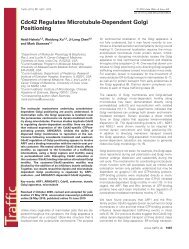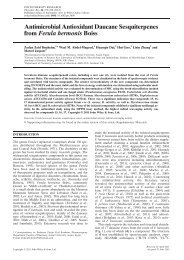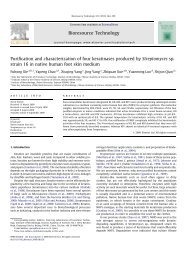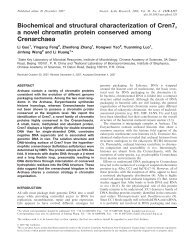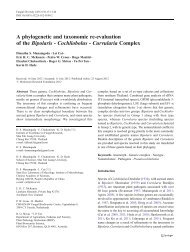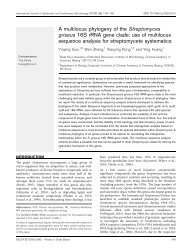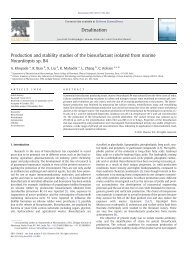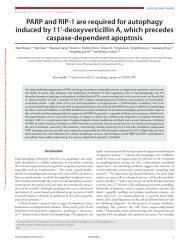Expression of cefF signiWcantly decreased deacetoxycephalosporin ...
Expression of cefF signiWcantly decreased deacetoxycephalosporin ...
Expression of cefF signiWcantly decreased deacetoxycephalosporin ...
You also want an ePaper? Increase the reach of your titles
YUMPU automatically turns print PDFs into web optimized ePapers that Google loves.
J Ind Microbiol Biotechnol<br />
DOI 10.1007/s10295-011-1025-5<br />
ORIGINAL PAPER<br />
<strong>Expression</strong> <strong>of</strong> <strong>cefF</strong> <strong>signiWcantly</strong> <strong>decreased</strong> <strong>deacetoxycephalosporin</strong> C<br />
formation during cephalosporin C production in Acremonium<br />
chrysogenum<br />
Yang An · Hailing Dong · Gang Liu<br />
Received: 5 May 2011 / Accepted: 4 August 2011<br />
© Society for Industrial Microbiology 2011<br />
Abstract Deacetoxycephalosporin C (DAOC) is not only<br />
the precursor but also one <strong>of</strong> the by-products during cephalosporin<br />
C (CPC) biosynthesis. One enzyme (DAOC/DAC<br />
synthase) is responsible for the two-step conversion <strong>of</strong> penicillin<br />
N into deacetylcephalosporin C (DAC) in Acremonium<br />
chrysogenum, while two enzymes (DAOC synthase and<br />
DAOC hydroxylase) were involved in this reaction in Streptomyces<br />
clavuligerus and Amycolatopsis lactamdurans<br />
(Nocardia lactamdurans). In this study, the DAOC hydroxylase<br />
gene <strong>cefF</strong> was cloned from Streptomyces clavuligerus<br />
and introduced into Acremonium chrysogenum through<br />
Agrobacterium tumefaciens-mediated transformation. When<br />
<strong>cefF</strong> was expressed under the promoter <strong>of</strong> pcbC, the ratio<br />
<strong>of</strong> DAOC/CPC in the fermentation broth <strong>signiWcantly</strong><br />
<strong>decreased</strong>. These results suggested that introduction <strong>of</strong> <strong>cefF</strong><br />
could function quite well in Acremonium chrysogenum and<br />
successfully reduce the content <strong>of</strong> DAOC in the CPC fermentation<br />
broth. This work oVered a practical way to<br />
improve the CPC puriWcation and reduce its production cost.<br />
Keywords <strong>cefF</strong> · Acremonium chrysogenum ·<br />
DAOC/CPC ratio<br />
Introduction<br />
Cephalosporin C (CPC), a beta-lactam antibiotic isolated in<br />
1956 from Acremonium chrysogenum (formerly Cephalosporium<br />
acremonium), has been successfully applied to<br />
Y. An · H. Dong · G. Liu (&)<br />
The Key Laboratory <strong>of</strong> Systematic Mycology and Lichenology,<br />
Institute <strong>of</strong> Microbiology, Chinese Academy <strong>of</strong> Sciences,<br />
Beijing 100101, China<br />
e-mail: liug@im.ac.cn<br />
manufacturing clinical drugs against human infections<br />
caused by penicillinase-producing bacteria for the last<br />
50 years [1, 24]. With the development <strong>of</strong> the pharmaceutical<br />
industry, the natural product CPC can be chemically<br />
synthesized into more active derivatives, which are less<br />
susceptible to penicillinase. 7-amino cephalosporanic acid<br />
(7-ACA), one <strong>of</strong> the CPC derivatives that shares 66% <strong>of</strong><br />
commercial cephalosporins production, is chemically synthesized<br />
by hydrolysis <strong>of</strong> the nucleus <strong>of</strong> CPC [23]. During<br />
this process, hydroxymethyl-7-aminocephalosporanic acid<br />
(7-ADCA) is also synthesized as a by-product and takes a<br />
concentration <strong>of</strong> 1–2%, which causes the impurity <strong>of</strong> the<br />
7-ACA production [6].<br />
The cephalosporin C biosynthetic pathway in A. chrysogenum<br />
has been well characterized both biochemically<br />
and genetically [11–14, 22, 25, 30, 31]. In this pathway,<br />
penicillin N is converted to DAOC (<strong>deacetoxycephalosporin</strong><br />
C) then to DAC (deacetylcephalosporin C) by one<br />
expandase/hydroxylase enzyme [11]. However, the DAOC<br />
could not be converted to DAC completely and a small<br />
amount <strong>of</strong> it accumulates in the fermentation broth and later<br />
is converted to 7-ADCA when the CPC is hydrolyzed to<br />
7-ACA.<br />
A similar CPC biosynthetic pathway is demonstrated in<br />
cephamycin (which is sometimes classiWed as cephalosporin)<br />
producing strain Streptomyces clavuligerus and Amycolatopsis<br />
lactamdurans (Nocardia lactamdurans) [20].<br />
However, these reactions from penicillin N to DAC were<br />
catalyzed by separate enzymes in S. clavuligerus and<br />
N. lactamdurans [7, 19]. The A. chrysogenum expandase/<br />
hydroxylase gene (cefEF) and the S. clavuligerus hydroxylase<br />
gene (<strong>cefF</strong>) have been cloned and sequenced, their amino<br />
acid sequences show a high degree <strong>of</strong> similarity [19, 25].<br />
Enzymatic study <strong>of</strong> the S. clavuligerus hydroxylase (CefF)<br />
also conWrmed the substrate speciWcity to DAOC [3]. To<br />
123
J Ind Microbiol Biotechnol<br />
reduce the contamination <strong>of</strong> DAOC, an attempt <strong>of</strong> adding<br />
an extra copy <strong>of</strong> cefEF gene in A. chrysogenum made a<br />
40–70% reduction in the DAOC level [6]. In this report, we<br />
have demonstrated that the S. clavuligerus hydroxylase<br />
gene (<strong>cefF</strong>) could function quite well in A. chrysogenum<br />
and successfully reduced the content <strong>of</strong> DAOC in the CPC<br />
fermentation broth. This work also showed a great possibility<br />
to reduce the cost <strong>of</strong> CPC puriWcation by improving the<br />
industrial strain through this way.<br />
Materials and methods<br />
Microbial strains and media<br />
Escherichia coli TOP10 was purchased from Transgen<br />
(Beijing, China) and used for plasmid construction. The<br />
cephamycin-producing strain Streptomyces clavuligerus<br />
CGMCC4.1611 was obtained from China General Microbiological<br />
Culture Collection Center (CGMCC). Micrococcus<br />
luteus CGMCC 1.1848, a β-lactam antibiotics-sensitive<br />
strain, was used as the indicator. The wild-type strain Acremonium<br />
chrysogenum CGMCC3.3795 was used as a host<br />
for DNA transformation and for producing cephalosporin<br />
C. Agrobacterium tumefaciens (updated scientiWc name:<br />
Rhizobium radiobacter) AGL-1 was provided by Pr<strong>of</strong>essor<br />
Xingzhong Liu (Institute <strong>of</strong> Microbiology, CAS).<br />
Escherichia coli and A. tumefaciens were grown in Luria<br />
broth (1% sodium chloride, 0.5% yeast extract, and 1% tryptone)<br />
or Luria broth agar. MM/IM/CM media were used in<br />
A. tumefaciens-mediated transformation [4, 17]. To isolate the<br />
genomic DNA, S. clavuligerus was grown in liquid TSB<br />
medium (Becton–Dickinson, Franklin Lakes, NJ) in a shake<br />
Xask at 28°C for 2 days. A. chrysogenum was incubated on<br />
TSA agar (1.7% tryptone, 0.3% tryptone soya broth, 0.25%<br />
glucose, 0.5% sodium chloride, 0.25% K 2 HPO 4 , and 1.5%<br />
agar) for growth. For sporulation, A. chrysogenum was cultured<br />
in LPE agar (0.1% glucose, 0.2% yeast extract, 0.15%<br />
sodium chloride, 1% calcium chloride, pH6.8, and 2.5% agar)<br />
at 28°C for 7 days. For fermentation, Wve plates <strong>of</strong> spores were<br />
collected and suspended in 2 ml <strong>of</strong> distilled water and then the<br />
spores were inoculated with 100 ml <strong>of</strong> seed medium in a 500-<br />
ml Xask on a 250-rpm rotary shaker at 25°C for 2 days [28].<br />
Then, 10 ml <strong>of</strong> seed culture was used to inoculate 100 ml <strong>of</strong><br />
deWned production medium (MDFA) in a 500-ml shake Xask<br />
[28]. These cultures (duplicate) were incubated in a rotary<br />
shaker at 25°C for 7 days. Production <strong>of</strong> β-lactam antibiotics<br />
was measured by bioassay against M. luteus CGMCC 1.1848.<br />
Plasmid construction<br />
Primers 5-gactagtGTGGATGGCACCTTTTGGG-3 and<br />
5-cggcgcgccGGTGACGGTTTGTCCTGCC-3 (SpeI and<br />
AscI sites were underlined) were used to amplify the promoter<br />
region (1,188 bps) <strong>of</strong> pcbC using the genomic DNA<br />
<strong>of</strong> A. chrysogenum as a template. Primers 5-aggcgcgcc<br />
CGAAGGAGCAGGGGAACA-3 and 5-ccctgcagg<br />
CGGCTTGAATGCAACGAC-3 (AscI and SbfI sites were<br />
underlined) were used to amplify <strong>cefF</strong> (1,091 bps) using the<br />
genomic DNA <strong>of</strong> S. clavuligerus as a template. Those<br />
ampliWed DNA fragments were ligated into the cloning<br />
vector pEASY-Blunt (Transgen, Beijing) and sequenced<br />
(Invitrogen, Shanghai) to verify their accuracy. Then, the<br />
DNA fragments were digested with the designed enzymes<br />
and ligated into the corresponding sites <strong>of</strong> pAg1-H3 [32]<br />
which was previously digested by SpeI/SbfI to generate the<br />
plasmid pAg1-H3-<strong>cefF</strong>.<br />
Agrobacterium tumefaciens-mediated transformation<br />
The plasmid pAg1-H3-<strong>cefF</strong> was introduced into the competent<br />
cells <strong>of</strong> A. tumefaciens AGL-1 via heat shock transformation<br />
[10, 15, 16]. One transformant was selected<br />
randomly and grown in MM at 28°C for 2 days at 250 rpm.<br />
The cultured cells were diluted to 0.15 <strong>of</strong> OD 600 in IM and<br />
incubated at 28°C for 6 h (OD 600 reaches 0.6) at 250 rpm.<br />
Mix 100 μl <strong>of</strong> the cultured cells with 100-μl suspensions <strong>of</strong><br />
dispersed A. chrysogenum spores (1 £ 10 7 spores per ml)<br />
and spread the mixture on CM agar plate. The mixture was<br />
incubated at 25°C in the dark for 3 days and transferred to a<br />
TSA agar plate supplemented with 50 μg/ml hygromycin B<br />
and 200 μM <strong>of</strong> cefotaxime. Colonies <strong>of</strong> hygromycin<br />
B-resistant transformants were selected after cultured at<br />
28°C for 4 days.<br />
Quantitative PCR<br />
Genomic DNA <strong>of</strong> A. chrysogenum was isolated by the phenol–chlor<strong>of</strong>orm<br />
method [2]. Absolute quantiWcation was<br />
performed to quantify the <strong>cefF</strong> copies <strong>of</strong> transformant<br />
using Mastercycler ® ep realplex equipment (Eppendorf,<br />
Germany) and SYBR ® Premix Ex Taq II PCR kit<br />
(Takara, Dalian). Standard curve <strong>of</strong> absolute quantiWcation<br />
was created by seven orders <strong>of</strong> magnitude dilution series<br />
(10 ¡1 to 10 ¡7 dilution) in triplicate <strong>of</strong> the water solution <strong>of</strong><br />
pAg1-H3-<strong>cefF</strong>. Samples were analyzed in triplicate from<br />
1/100–1/200 dilution <strong>of</strong> the original PCR product. Primers<br />
5-ACGTCGAGCGTCTTCTTCCT-3 and 5-TTCTTC<br />
GCGTGCATGGTG-3 were used in this experiment. Then,<br />
2 μl <strong>of</strong> diluted template DNA, 9.5 μl <strong>of</strong> water, and 0.5 μl<br />
each <strong>of</strong> the primers were added to 12.5 μl <strong>of</strong> PCR mix and<br />
subjected to 40 cycles <strong>of</strong> PCR (5 s at 95°C and 30 s at<br />
65°C). Melting curve analysis after the cycling conWrmed<br />
the absence <strong>of</strong> non-speciWc products in the reaction. The<br />
Xuorescence threshold (Ct) values were calculated for standards<br />
and samples by using the realplex s<strong>of</strong>tware.<br />
123
J Ind Microbiol Biotechnol<br />
RNA isolation and RT-PCR<br />
Total RNA was isolated from A. chrysogenum grown in<br />
deWned fermentation medium (MDFA) as described previously<br />
[21]. RNA was puriWed by TRIzol and treated with<br />
DNase I (Promega) before random 6 mers primed reverse<br />
transcription with PrimeScript ® RT reagent kit as described<br />
by the vendor <strong>of</strong> the enzyme (Takara, Dalian). No remaining<br />
DNA was detected by the PCR ampliWcation <strong>of</strong> the <strong>cefF</strong><br />
gene. cDNA product <strong>of</strong> the reverse transcription was used<br />
as the template to amplify the <strong>cefF</strong> gene under the same<br />
conditions as described in the construction <strong>of</strong> pAg1-H3-<br />
<strong>cefF</strong>.<br />
LC-MS analysis<br />
To analyze the CPC production, A. chrysogenum was<br />
inoculated in seed medium and deWned fermentation<br />
medium (MDFA). All fermentation experiments were<br />
performed in triplicate. The CPC production in fermentation<br />
broth was measured by bioassay against M. luteus.<br />
After the fermentation broth was Wltered by a 0.2-μm<br />
micro PES membrane (MEMBRANA, Germany), 20 μl <strong>of</strong><br />
sample was directly applied to Agilent 1200 HPLC with<br />
Thermo Hypersil Gold C18 column and 6520 Q-TOF<br />
mass system for CPC and DAOC production analysis.<br />
Standard sample <strong>of</strong> cephalosporin C zinc salt (cat #3270,<br />
Sigma-Aldrich) was used to set up the method <strong>of</strong> HPLC.<br />
The mobile phase was acetonitrile and distilled water<br />
(containing 0.05% formic acid) with the gradient from<br />
2:98 (v/v) to 20:80 (v/v) in 20 min at the temperature <strong>of</strong><br />
35°C. The Xow rate was 1 ml/min. The high-resolution<br />
MS analysis was carried out with the electrospray ionization<br />
source in the positive mode. The gas temperature and<br />
fragmentor were set at 300°C and 115 V, respectively.<br />
The drying gas Xow was 10 l/min.<br />
Fig. 1 Map <strong>of</strong> pAg1-H3-<strong>cefF</strong> carrying the <strong>cefF</strong> gene. <strong>cefF</strong>, DAOC<br />
hydroxylase gene under the control <strong>of</strong> the promoter <strong>of</strong> pcbC (PpcbC)<br />
for expression in A. chrysogenum; kanR, kanamycin resistance gene;<br />
hph, hygromycin resistance gene under the control <strong>of</strong> the promoter<br />
(PtrpC) and the terminator (TtrpC) <strong>of</strong> trpC gene. RB T-DNA right border,<br />
LB T-DNA left border. Restriction enzymes in bold are unique cutting<br />
sites in the plasmid<br />
Fig. 2 Transcriptional analysis <strong>of</strong> <strong>cefF</strong> in A. chrysogenum. Lane 1,<br />
1-kb DNA marker; Lane 2, PCR product using genomic DNA <strong>of</strong> transformant<br />
B6 as a template; Lane 3, PCR product using genomic DNA<br />
<strong>of</strong> wild-type strain as a template; Lane 4, PCR product using cDNA <strong>of</strong><br />
transformant B6 as a template; Lane 5, PCR product using cDNA <strong>of</strong><br />
wild-type as a template; Lane 6, PCR product using pAg1-H3-<strong>cefF</strong> as<br />
positive control<br />
Table 1 Absolute quantiWcation <strong>of</strong> <strong>cefF</strong> gene copy number<br />
Sample applied<br />
Quantity<br />
applied<br />
Amount<br />
mean SYBR<br />
Copy<br />
number<br />
1/100 diluted<br />
genomic DNA<br />
1/200 diluted<br />
genomic DNA<br />
2.4 £ 10 6<br />
molecules<br />
2.51 £ 10 6<br />
molecules<br />
1<br />
2.3 £ 10 6<br />
molecules<br />
2.07 £ 10 6<br />
molecules<br />
1<br />
Fig. 3 Bioassay <strong>of</strong> the fermentation broth from B6 and the wild-type<br />
strain against M. luteus<br />
123
J Ind Microbiol Biotechnol<br />
Results<br />
<strong>Expression</strong> <strong>of</strong> <strong>cefF</strong> in A. chrysogenum<br />
To express the <strong>cefF</strong> in A. chrysogenum, the plasmid pAg1-<br />
H3-<strong>cefF</strong> was constructed. pAg1-H3-<strong>cefF</strong> carried a hygromycin<br />
B-resistant cassette (hph), kanamycin resistance<br />
gene (kanR), T-DNA region, and the gene <strong>cefF</strong> under the<br />
promoter <strong>of</strong> pcbC (Fig. 1).<br />
The plasmid pAg1-H3-<strong>cefF</strong> was introduced into<br />
A. chrysogenum through A. tumefaciens-mediated transformation.<br />
The hygromycin B resistance transformants were<br />
selected and conWrmed by PCR. These transformants did<br />
not show diVerence in growth and morphological diVerentiation<br />
compared to the wild-type strain (data not shown).<br />
For fermentation, one transformant was selected randomly<br />
and it was designated as B6. Absolute quantiWcation <strong>of</strong> <strong>cefF</strong><br />
conWrmed that only one copy had been inserted in the chromosome<br />
<strong>of</strong> B6 (Table 1). RT-PCR result showed that <strong>cefF</strong><br />
was transcribed normally in B6, and no signal was<br />
observed in the wild-type strain (Fig. 2). However, the CPC<br />
production <strong>of</strong> B6 did not show a signiWcant diVerence compared<br />
to that <strong>of</strong> the wild-type strain through bioassay<br />
against M. luteus (Fig. 3).<br />
Analysis <strong>of</strong> DAOC/CPC in the fermentation broth<br />
The fermentation broth was further analyzed by LC–MS.<br />
Due to impurity <strong>of</strong> the standard sample, DAOC, DAC, and<br />
CPC could be detected by comparing the corresponding<br />
molecular weight. The HPLC method applied here could<br />
separate the DAOC and CPC within an appropriate retention<br />
time. The retention time <strong>of</strong> DAOC was approximately<br />
9.5 min, while the retention time <strong>of</strong> CPC was 10.2 min<br />
(Fig. 4). The DAOC, DAC, and CPC in each sample were<br />
analyzed, respectively, by a high-resolution MS monitor.<br />
The area <strong>of</strong> response signal peak was calculated by the Agilent<br />
LC–MS s<strong>of</strong>tware. The resulting value had been processed<br />
with statistical analysis (Table 2). According to the<br />
peak area, the average ratios <strong>of</strong> DAOC/CPC and DAOC/<br />
DAC in the fermentation broth <strong>of</strong> the wild-type strain were<br />
14.24 and 7.84, while their average ratios were dramatically<br />
<strong>decreased</strong> to 1.34 and 0.49 in B6 fermentation broth<br />
(Table 2). The result also showed that the average ratio <strong>of</strong><br />
DAC/CPC increased in B6 fermentation broth comapared<br />
to that <strong>of</strong> the wild-type strain broth, but not <strong>signiWcantly</strong>. It<br />
is possible that DAC could be converted into CPC<br />
eYciently in this strain and keep the dynamic balance<br />
between DAC and CPC. The amount <strong>of</strong> DAOC in the fermentation<br />
broth <strong>of</strong> B6 <strong>decreased</strong> more than tenfold comapared<br />
to that <strong>of</strong> the wild-type strain. This suggested that<br />
expression <strong>of</strong> <strong>cefF</strong> could <strong>signiWcantly</strong> reduce the content <strong>of</strong><br />
DAOC in the CPC fermentation broth <strong>of</strong> A. chrysogenum.<br />
Discussion<br />
For 50 years, intensive strain improvement has resulted in a<br />
<strong>signiWcantly</strong> higher titer <strong>of</strong> the CPC production in A. chrysogenum<br />
through traditional mutagenesis and genetic engineering.<br />
For example, it has been proven that introducing<br />
cefEF and cefG, which was identiWed as a coding gene <strong>of</strong><br />
rate-limiting DAC-acetyltransferase, increased the yield <strong>of</strong><br />
CPC by 40% [23, 29]. <strong>Expression</strong> <strong>of</strong> cefG under the heterologous<br />
gdh or gpd promoter increased the CPC titer up to<br />
two or threefold [14]. Besides ampliWcation <strong>of</strong> the key biosynthetic<br />
enzymes, improvement <strong>of</strong> corresponding enzymatic<br />
activity <strong>of</strong> precursor synthesis and oxygen supply<br />
also stimulated CPC production [9, 21]. However, none <strong>of</strong><br />
these methods have gained as much achievement as multiple<br />
rounds <strong>of</strong> mutagenesis and screening. Modifying the<br />
industrial strain by enhancing the purity <strong>of</strong> CPC production<br />
will be more practical to the modern pharmaceutical industry.<br />
In the application reported here, adding a single copy <strong>of</strong><br />
<strong>cefF</strong> could <strong>signiWcantly</strong> reduce the ratio <strong>of</strong> DAOC/CPC.<br />
We suggest that this byproduct (DAOC) could be reduced<br />
further by switching other promoters or introducing extra<br />
copies.<br />
As there is a lack <strong>of</strong> available genetic tools, molecular<br />
engineering in A. chrysogenum is still very limited so far.<br />
Since the demonstration <strong>of</strong> successful T-DNA transfer into<br />
Saccharomyces cerevisiae by A. tumefaciens, ATMT has<br />
been successfully applied to transform a diverse array <strong>of</strong><br />
fungi [4, 5, 8, 18]. This technique exhibits many advantages<br />
for the genetic analysis <strong>of</strong> fungi. Our study showed that<br />
A. tumefaciens-mediated transformation was an eYcient<br />
method for the introduction <strong>of</strong> heterologous genes into<br />
A. chrysogenum. With the high transformation eYciency<br />
resulting in one transformant per 1 £ 10 4 spores, more than<br />
30 transformants were collected once in this work, and the<br />
genetic screen marker remained stable after Wve generations.<br />
The high-yielding industrial strains <strong>of</strong> A. chrysogenum<br />
were obtained via constant mutagenesis, and a variety <strong>of</strong><br />
genetic changes occurred and accumulated in these strains,<br />
therefore the industrial strains are diVerent from their parents.<br />
In contrast to the penicillin-producing strain Penicillium<br />
chrysogenum, either the wild-type strain or the<br />
industrial strains <strong>of</strong> A. chrysogenum contain only one copy<br />
<strong>of</strong> the CPC biosynthetic gene cluster [26]. Though the<br />
strain <strong>of</strong> A. chrysogenum examined in this study is the wildtype<br />
strain and produced less CPC in the assay <strong>of</strong> Xask fermentation<br />
than the industrial strains that had been reported<br />
in other references [6, 21, 27], they all produce CPC<br />
through the same biosynthetic pathway. We suggest that<br />
this method could also be applied in the industrial strain. As<br />
presented, the transformant in this work showed a tenfold<br />
decline <strong>of</strong> the accumulation <strong>of</strong> DAOC. This application<br />
should help to decrease the cost <strong>of</strong> CPC production.<br />
123
J Ind Microbiol Biotechnol<br />
Fig. 4 LC-MS spectrum <strong>of</strong> the<br />
fermentation broths from transformant<br />
B6 (a) and the wild-type<br />
strain (b)<br />
Table 2 Analysis <strong>of</strong> the DAOC/CPC ratio in the fermentation broth <strong>of</strong> B6 and the wild-type strain based on the peak areas observed from LC–MS<br />
Ratio <strong>of</strong> DAOC/CPC Ratio <strong>of</strong> DAOC/DAC Ratio <strong>of</strong> DAC/CPC<br />
Control B6 Control B6 Control B6<br />
Mean value 14.24 1.34 7.84 0.49 2.20 2.82<br />
Variance 53.77 0.06 23.27 0.01 1.72 0.91<br />
Observations 3 3 3 3 3 3<br />
123
J Ind Microbiol Biotechnol<br />
Acknowledgments We thank Pr<strong>of</strong>. Xingzhong Liu (Institute <strong>of</strong><br />
Microbiology, CAS) for providing plasmid pAg1-H3 and A. tumefaciens<br />
strain AGL-1. We thank Dr. Jinwei Ren and Dr. Wenzhao Wang<br />
(Institute <strong>of</strong> Microbiology, CAS) for performing the analytical assay <strong>of</strong><br />
LC–MS. This work was supported by the Knowledge Innovation Program<br />
<strong>of</strong> the Chinese Academy <strong>of</strong> Sciences (Grant No. KSCX2-EW-J-6)<br />
and the Ministry <strong>of</strong> Science and Technology <strong>of</strong> China (Grant No.<br />
2010ZX09401-403).<br />
References<br />
1. Abraham EP, Newton GG (1961) The structure <strong>of</strong> cephalosporin<br />
C. Biochem J 79:377–393<br />
2. An Y, Yang J, Xu X, Liu G (2009) Construct cosmid libraries by<br />
isolating large genomic DNA fragments from Monascus ruber.<br />
Wei Sheng Wu Xue Bao 49(10):1385–1388<br />
3. Baker BJ, Dotzlaf JE, Yeh WK (1991) Deacetoxycephalosporin C<br />
hydroxylase <strong>of</strong> Streptomyces clavuligerus. PuriWcation, characterization,<br />
bifunctionality, and evolutionary implication. J Biol Chem<br />
266:5087–5093<br />
4. Bundock P, den Dulk-Ras A, Beijersbergen A, Hooykaas PJ<br />
(1995) Trans-kingdom T-DNA transfer from Agrobacterium tumefaciens<br />
to Saccharomyces cerevisiae. EMBO J 14:3206–3214<br />
5. Campoy S, Pérez F, Martín F, Gutiérrez S, Liras P (2003) Stable<br />
transformants <strong>of</strong> the azaphilone pigment-producing Monascus<br />
purpureus obtained by protoplast transformation and Agrobacterium-mediated<br />
DNA transfer. Curr Genet 43:447–452<br />
6. Chiang JB (1998) Genetic engineering approach to reduce undesirable<br />
by-products in cephalosporin C fermentation. J Ind Microbiol<br />
Biot 20:344–353<br />
7. Coque JJ, Martín JF, Liras P (1993) Characterization and expression<br />
in Streptomyces lividans <strong>of</strong> cefD and cefE genes from Nocardia<br />
lactamdurans: the organization <strong>of</strong> the cephamycin gene cluster<br />
diVers from that in Streptomyces clavuligerus. Mol Gen Genet<br />
236(2–3):453–458<br />
8. de Groot MJA, Bundock P, Hooykaas PJJ, Beijersbergen AGM<br />
(1998) Agrobacterium tumefaciens-mediated transformation <strong>of</strong><br />
Wlamentous fungi. Nat Biotechnol 16:839–842<br />
9. DeModena JA, Gutierrez S, Velasco J, Fernandez FJ, Fachini RA,<br />
Galazzo JL, Hughes DE, Martin JF (1993) The production <strong>of</strong> cephalosporin<br />
C by Acremonium chrysogenum is improved by the<br />
intracellular expression <strong>of</strong> a bacterial hemoglobin. Biotechnology<br />
(NY) 11:926–929<br />
10. Dityatkin SY, Lisovskaya KV, Panzhava NN, Iliashenko BN<br />
(1972) Frozen-thawed bacteria as recipients <strong>of</strong> isolated coliphage<br />
DNA. Biochim Biophys Acta 281:319–323<br />
11. Dotzlaf JE, Yeh WK (1987) CopuriWcation and characterization <strong>of</strong><br />
<strong>deacetoxycephalosporin</strong> C synthetase/hydroxylase from Cephalosporium<br />
acremonium. J Bacteriol 169:1611–1618<br />
12. Gutierrez S, Diez B, Montenegro E, Martin JF (1991) Characterization<br />
<strong>of</strong> the Cephalosporium acremonium pcbAB gene encoding<br />
alpha-aminoadipyl-cysteinyl-valine synthetase, a large multidomain<br />
peptide synthetase: linkage to the pcbC gene as a cluster <strong>of</strong><br />
early cephalosporin biosynthetic genes and evidence <strong>of</strong> multiple<br />
functional domains. J Bacteriol 173:2354–2365<br />
13. Gutiérrez S, Velasco J, Fernandez FJ, Martín JF (1992) The cefG<br />
gene <strong>of</strong> Cephalosporium acremonium is linked to the cefEF gene<br />
and encodes a deacetylcephalosporin C acetyltransferase closely<br />
related to homoserine O-acetyltransferase. J Bacteriol 174:3056–<br />
3064<br />
14. Gutierrez S, Velasco J, Marcos AT, Fernandez FJ, Fierro F, Barredo<br />
JL, Diez B, Martin JF (1997) <strong>Expression</strong> <strong>of</strong> the cefG gene is<br />
limiting for cephalosporin biosynthesis in Acremonium chrysogenum.<br />
Appl Microbiol Biotechnol 48:606–614<br />
15. H<strong>of</strong>gen R, Willmitzer L (1988) Storage <strong>of</strong> competent cells for<br />
Agrobacterium transformation. Nucleic Acids Res 16:9877<br />
16. Holsters M, de Waele D, Depicker A, Messens E, van Montagu M,<br />
Schell J (1978) Transfection and transformation <strong>of</strong> Agrobacterium<br />
tumefaciens. Mol Gen Genet 163:181–187<br />
17. Hooykaas PJJ, Roobol C, Schilperoort RA (1979) Regulation <strong>of</strong><br />
the transfer <strong>of</strong> TI plasmids <strong>of</strong> Agrobacterium tumefaciens. J Gen<br />
Microbiol 110:99–109<br />
18. Kang S, Metzenberg RL (1993) Insertional mutagenesis in Neurospora<br />
crassa: cloning and molecular analysis <strong>of</strong> the preg+ gene<br />
controlling the activity <strong>of</strong> the transcriptional activator NUC-1.<br />
Genetics 133:193–202<br />
19. Kovacevic S, Miller JR (1991) Cloning and sequencing <strong>of</strong> the<br />
beta-lactam hydroxylase gene (<strong>cefF</strong>) from Streptomyces clavuligerus:<br />
gene duplication may have led to separate hydroxylase and<br />
expandase activities in the actinomycetes. J Bacteriol 173:398–400<br />
20. Liras P, Demain AL (2009) Chapter 16. Enzymology <strong>of</strong> beta-lactam<br />
compounds with cephem structure produced by actinomycete.<br />
Methods Enzymol 458:401–429<br />
21. Liu G, Casqueiro J, Banuelos O, Cardoza RE, Gutierrez S, Martin<br />
JF (2001) Targeted inactivation <strong>of</strong> the mecB gene, encoding cystathionine-gamma-lyase,<br />
shows that the reverse transsulfuration<br />
pathway is required for high-level cephalosporin biosynthesis in<br />
Acremonium chrysogenum C10 but not for methionine induction<br />
<strong>of</strong> the cephalosporin genes. J Bacteriol 183:1765–1772<br />
22. Martin JF, Ullan RV, Casqueiro J (2004) Novel genes involved in<br />
cephalosporin biosynthesis: the three-component isopenicillin N<br />
epimerase system. Adv Biochem Eng Biotechnol 88:91–109<br />
23. Matsuda A, Sugiura H, Matsuyama K, Matsumoto H, Ichikawa S,<br />
Komatsu K (1992) Cloning and disruption <strong>of</strong> the cefG gene encoding<br />
acetyl coenzyme A: deacetylcephalosporin C O-acetyltransferase<br />
from Acremonium chrysogenum. Biochem Biophys Res<br />
Commun 186:40–46<br />
24. Newton GG, Abraham EP (1956) Isolation <strong>of</strong> cephalosporin C, a<br />
penicillin-like antibiotic containing D-alpha-aminoadipic acid.<br />
Biochem J 62:651–658<br />
25. Samson SM, Dotzlaf JE, Slisz ML, Becker GW, Van Frank RM,<br />
Veal LE, Yeh WK, Miller JR, Queener SW, Ingolia TD (1987)<br />
Cloning and expression <strong>of</strong> the fungal expandase/hydroxylase gene<br />
involved in cephalosporin biosynthesis. Nat Biotechnol 5:1207–<br />
1214<br />
26. Schmitt EK, HoV B, Kuck U (2004) Regulation <strong>of</strong> cephalosporin<br />
biosynthesis. Adv Biochem Engin/Biotechnol 88:1–43<br />
27. Sen BKB (2006) Antibiotics business: a glimpse. Indian J Biotechnol<br />
5:471–476<br />
28. Shen YQ, Wolfe S, Demain AL (1986) Levels <strong>of</strong> isopenicillin N<br />
synthetase and <strong>deacetoxycephalosporin</strong> C synthetase. Nat Biotechnol<br />
4:61–64<br />
29. Skatrud PL, Tietz AJ, Ingolia TD, Cantwell CA, Fisher DL, Chapman<br />
JL, Queener SW (1989) Use <strong>of</strong> recombinant DNA to improve<br />
production <strong>of</strong> cephalosporin C by Cephalosporium acremonium.<br />
Nat Biotechnol 7:477–485<br />
30. Ullan RV, Casqueiro J, Banuelos O, Fernandez FJ, Gutierrez S,<br />
Martin JF (2002) A novel epimerization system in fungal secondary<br />
metabolism involved in the conversion <strong>of</strong> isopenicillin N into<br />
penicillin N in Acremonium chrysogenum. J Biol Chem<br />
277:46216–46225<br />
31. Ullan RV, Liu G, Casqueiro J, Gutierrez S, Banuelos O, Martin JF<br />
(2002) The cefT gene <strong>of</strong> Acremonium chrysogenum C10 encodes a<br />
putative multidrug eZux pump protein that <strong>signiWcantly</strong> increases<br />
cephalosporin C production. Mol Genet Genomics 267:673–683<br />
32. Zhang A, Lu P, Dahl-Roshak AM, Paress PS, Kennedy S, Tkacz<br />
JS, An Z (2003) EYcient disruption <strong>of</strong> a polyketide synthase gene<br />
(pks1) required for melanin synthesis through Agrobacteriummediated<br />
transformation <strong>of</strong> Glarea lozoyensis. Mol Genet Genomics<br />
268:645–655<br />
123





